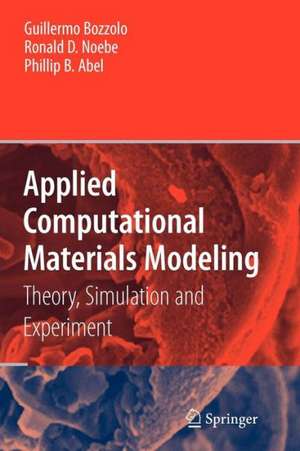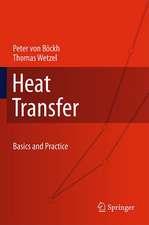Applied Computational Materials Modeling: Theory, Simulation and Experiment
Editat de Guillermo Bozzolo, Ronald D. Noebe, Phillip B. Abelen Limba Engleză Paperback – 29 oct 2010
| Toate formatele și edițiile | Preț | Express |
|---|---|---|
| Paperback (1) | 954.45 lei 6-8 săpt. | |
| Springer Us – 29 oct 2010 | 954.45 lei 6-8 săpt. | |
| Hardback (1) | 957.62 lei 6-8 săpt. | |
| Springer Us – 12 oct 2007 | 957.62 lei 6-8 săpt. |
Preț: 954.45 lei
Preț vechi: 1163.97 lei
-18% Nou
Puncte Express: 1432
Preț estimativ în valută:
182.63€ • 191.20$ • 151.12£
182.63€ • 191.20$ • 151.12£
Carte tipărită la comandă
Livrare economică 05-19 aprilie
Preluare comenzi: 021 569.72.76
Specificații
ISBN-13: 9781441935755
ISBN-10: 1441935754
Pagini: 508
Ilustrații: XVI, 491 p.
Dimensiuni: 155 x 235 x 27 mm
Greutate: 0.7 kg
Ediția:Softcover reprint of hardcover 1st ed. 2007
Editura: Springer Us
Colecția Springer
Locul publicării:New York, NY, United States
ISBN-10: 1441935754
Pagini: 508
Ilustrații: XVI, 491 p.
Dimensiuni: 155 x 235 x 27 mm
Greutate: 0.7 kg
Ediția:Softcover reprint of hardcover 1st ed. 2007
Editura: Springer Us
Colecția Springer
Locul publicării:New York, NY, United States
Public țintă
ResearchCuprins
Ab initio modeling of alloy phase equilibria.- Use of computational thermodynamics to identify potential alloy compositions for metallic glass formation.- How does a crystal grow? Experiments, models and simulations from the nano- to the micro-scale regime.- Structural and electronic properties from first-principles.- Synergy between material, surface science experiments and simulations.- Integration of first-principles calculations, calphad modeling, and phase-field simulations.- Quantum approximate methods for the atomistic modeling of multicomponent alloys.- Molecular orbital approach to alloy design.- Application of computational and experimental techniques in intelligent design of age-hardenable aluminum alloys.- Multiscale modeling of intergranular fracture in metals.- Multiscale modeling of deformation and fracture in metallic materials.- Frontiers in surface analysis: Experiments and modeling.- The evolution of composition and structure at metal-metal interfaces: Measurements and simulations.- Modeling of low enrichment uranium fuels for research and test reactors.
Textul de pe ultima copertă
Applied Computational Modeling identifies and emphasizes the successful link between computational materials modeling as a simulation and design tool and its synergistic application to experimental research and alloy development. Compared to other areas in science where computational modeling has made substantial contributions to the development and growth of a particular field, computational materials modeling has been rather limited in its ability to insert itself as a major tool in materials design. The impression that computational modeling is simply an intellectual pursuit with limited real life application has delayed its widespread use by the mainstream materials community, but as in any emerging field, the time has come where it is now difficult to imagine any vigorous materials development program without a strong foundation in modeling.
Hence, this book provides the average person working in the materials field with a more balanced perspective of the role that computational modeling can play in every day research and development efforts. This is done by presenting a series of examples of the successful application of various computational modeling procedures (everything from first principles to quantum approximate to CALPHAD methods) to real life surface and bulk alloy problems.
This book should have a large appeal in the materials community, both for experimentalists who would greatly benefit from adding computational methods to their everyday research regimes, as well as for those scientists/engineers familiar with a particular computational method who would like to add complementary techniques to their arsenal of research and development tools.
Hence, this book provides the average person working in the materials field with a more balanced perspective of the role that computational modeling can play in every day research and development efforts. This is done by presenting a series of examples of the successful application of various computational modeling procedures (everything from first principles to quantum approximate to CALPHAD methods) to real life surface and bulk alloy problems.
This book should have a large appeal in the materials community, both for experimentalists who would greatly benefit from adding computational methods to their everyday research regimes, as well as for those scientists/engineers familiar with a particular computational method who would like to add complementary techniques to their arsenal of research and development tools.
Caracteristici
Computational materials modeling is presented as a set of tools available for aiding the materials engineer/scientist Each chapter describes one or more particular computational tool and how they are best used Provides detailed examples of application to real problems Suggests how to acquire the programs (tools) if the software is publicly available Focuses on the integration of the modeling methods within experimental programs Includes supplementary material: sn.pub/extras










